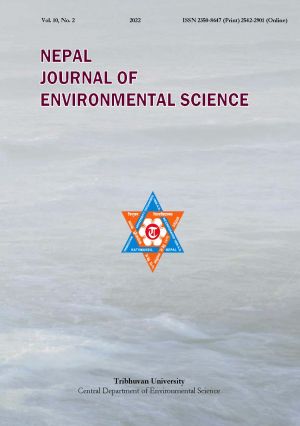Evaluation of benthic macroinvertebrate communities in upstream and downstream of Kulekhani Multipurpose Reservoir, Makawanpur, Nepal
DOI:
https://doi.org/10.3126/njes.v10i2.38142Keywords:
Benthic macroinvertebrates, dam, diversity indexAbstract
Reservoir construction in the natural waterways can disrupt the structure and function of riparian ecosystems with the alteration in abundance and composition of aquatic organisms. This study assessed the variation in Benthic Macroinvertebrates (BMIs) communities in upstream (Chitlang and Seti Streams) and downstream (spillway) of Kulekhani multipurpose reservoir, Makawanpur, Nepal. Multi-habitat qualitative samplings with Ganga River System Biotic Score (GRSBIOS) index was used for the biological water quality assessment. Out of total 25 families and 8 orders of identified BMIs, Diptera and Coleoptera order are abundant whereas Oligochaeta and Odonata order are lowest. Taxa richness and abundance of BMIs were estimated to be higher upstream. Number of EPT taxa (6 to 2) and percentage of EPT (35.07 to 28.04 %) abundance were recorded in decreasing order of response toward downstream. The upstream showed a high Shannon and Simpson’s diversity index. Chitlang Stream is found slightly polluted as Average Score Per Taxa (ASPT) score is calculated as 6.1 (River Water Quality Status (RWQS)-I)). Similarly, immediate downstream is critically polluted with RWQS-III whereas Seti Stream and spillway after 4 km were found to be moderately polluted as RWQS-II. Canonical Correspondence Analysis (CCA) showed that pH, temperature, and dissolved oxygen have a high influence in BMIs assemblages. The study depicts the ecological health of the stream immediately downstream of the reservoir is disturbed with presence of tolerant BMIs assemblages. The implication of the study can be in the assessment of impact caused by the reservoir in the ecological status of the water transfer.
Downloads
Downloads
Published
How to Cite
Issue
Section
License
Copyright (c) 2022 Central Department of Environmental Science, Tribhuvan University

This work is licensed under a Creative Commons Attribution-NonCommercial 4.0 International License.
This license enables reusers to distribute, remix, adapt, and build upon the material in any medium or format for noncommercial purposes only, and only so long as attribution is given to the creator.




